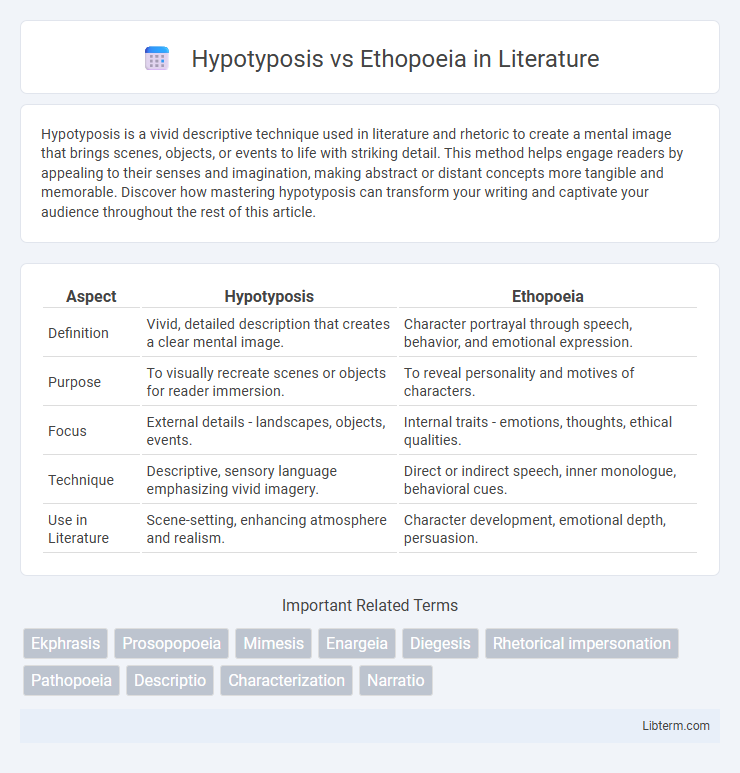Hypotyposis is a vivid descriptive technique used in literature and rhetoric to create a mental image that brings scenes, objects, or events to life with striking detail. This method helps engage readers by appealing to their senses and imagination, making abstract or distant concepts more tangible and memorable. Discover how mastering hypotyposis can transform your writing and captivate your audience throughout the rest of this article.
Table of Comparison
| Aspect | Hypotyposis | Ethopoeia |
|---|---|---|
| Definition | Vivid, detailed description that creates a clear mental image. | Character portrayal through speech, behavior, and emotional expression. |
| Purpose | To visually recreate scenes or objects for reader immersion. | To reveal personality and motives of characters. |
| Focus | External details - landscapes, objects, events. | Internal traits - emotions, thoughts, ethical qualities. |
| Technique | Descriptive, sensory language emphasizing vivid imagery. | Direct or indirect speech, inner monologue, behavioral cues. |
| Use in Literature | Scene-setting, enhancing atmosphere and realism. | Character development, emotional depth, persuasion. |
Introduction to Hypotyposis and Ethopoeia
Hypotyposis is a rhetorical device that vividly describes scenes, objects, or events to create a mental image for the audience, enhancing sensory engagement and emotional impact. Ethopoeia involves the imitation or representation of a character's voice and mindset, allowing speakers or writers to convey personality, emotions, and ethical perspective through stylistic portrayal. Both techniques enrich narrative and persuasive communication by intensifying imagery and character expression.
Defining Hypotyposis
Hypotyposis is a vivid descriptive technique that creates a mental image through detailed sensory language, often bringing scenes or objects to life with rich, concrete details. Unlike ethopoeia, which focuses on character portrayal through speech or behavior, hypotyposis emphasizes visual and sensory impressions to immerse the reader. This rhetorical device is commonly used in literature and oratory to render abstract or distant concepts tangibly immediate and vivid.
Defining Ethopoeia
Ethopoeia is a rhetorical device that involves the vivid representation of a character's personality, emotions, and thoughts, often through direct speech or detailed description, enhancing the audience's emotional engagement. Unlike hypotyposis, which emphasizes the striking visual or sensory description of a scene or event, ethopoeia centers on capturing the moral and psychological traits of individuals. This technique is integral to classical rhetoric, enabling speakers and writers to create compelling, realistic portrayals that influence listeners' or readers' perceptions.
Historical Origins of Both Rhetorical Devices
Hypotyposis originated in ancient Greek rhetoric as a vivid, descriptive technique used by orators like Demosthenes to create mental images for audiences, emphasizing sensory detail and dynamic portrayal. Ethopoeia also traces back to classical rhetoric, especially Aristotle and Cicero, involving the impersonation or portrayal of a character's ethos to persuade by adopting their voice and mannerisms. Both devices served distinct but complementary roles in enhancing persuasive speech through imagery and character embodiment in antiquity.
Key Differences Between Hypotyposis and Ethopoeia
Hypotyposis involves vivid, detailed descriptions that create a visual impression, emphasizing sensory imagery to bring scenes or objects to life. Ethopoeia centers on the portrayal of a character's inner thoughts, emotions, and moral qualities, focusing on psychological and ethical aspects. The key difference lies in Hypotyposis's external, descriptive nature contrasted with Ethopoeia's introspective character representation.
Functions in Classical Rhetoric
Hypotyposis creates vivid, detailed imagery to make abstract ideas concrete and emotionally engaging, enhancing audience visualization. Ethopoeia constructs a character's voice or persona to persuade by embodying ethos and appealing to the audience's emotions and moral judgments. Both serve to intensify rhetorical effect, with Hypotyposis emphasizing descriptive clarity and Ethopoeia focusing on character-driven persuasion.
Modern Applications in Literature
Hypotyposis vividly describes scenes or objects with striking sensory detail, enhancing readers' immersive experience in modern literature. Ethopoeia conveys characters' inner thoughts and emotions, enabling deeper psychological insights and authenticity in narrative voice. Contemporary writers strategically blend hypotyposis and ethopoeia to create multi-dimensional storytelling that balances visual imagery with emotional depth.
Impact on Reader’s Perception
Hypotyposis creates vivid, descriptive imagery that immerses readers in a scene, enhancing sensory perception and emotional engagement. Ethopoeia characterizes a person's inner thoughts and emotions, fostering empathy and a deeper psychological connection with the subject. Together, these rhetorical devices shape the reader's understanding by combining external visualization with internal perspective for a comprehensive experience.
Famous Examples in Literary Works
Hypotyposis vividly describes scenes or objects with such detail that readers visualize them clearly, famously exemplified in Homer's "Iliad" during the dramatic battlefield descriptions. Ethopoeia, on the other hand, centers on portraying a character's thoughts, emotions, or personality, effectively illustrated in Shakespeare's portrayal of Hamlet's introspective soliloquies. These rhetorical devices enrich narratives by either immersing readers in sensory experiences or deepening psychological insights through exemplary literary works.
Conclusion: Choosing the Right Device
Hypotyposis vividly paints scenes with detailed visual imagery, ideal for engaging readers through sensory experience. Ethopoeia emphasizes character portrayal and emotional depth, strengthening narrative connection by conveying psychological or moral traits. Selecting between hypotyposis and ethopoeia depends on whether the focus is on immersive description or character insight to best serve the rhetorical purpose.
Hypotyposis Infographic

 libterm.com
libterm.com